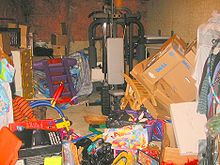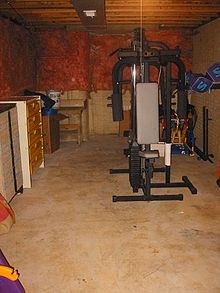This article may need to be rewritten to comply with Wikipedia's quality standards. (February 2024) |
Decluttering means removing unnecessary items, sorting and arranging, or putting things back in place. This article deals with the clearing of places of residence, such as in homes and commercial buildings,[1] but the principles can also be applied to other areas. The activity can be done independently, or with help from family, friends or professionals.


There are many methods for systematic decluttering and organizing. Some recent examples are danshari and konmari. In danshari, a distinction is made between minimalists (who try to minimize their belongings) and those who try to optimize their belongings.
History
editCutting out unnecessary things, letting go of superfluous things and becoming free of attachment to things has roots in Buddhist philosophy.[clarification needed][citation needed]
In 1984, professional organizing emerged as an industry in Los Angeles, USA.[2]
In 2009, Hideko Yamashita introduced the danshari method in her book Danshari: Shin Katazukejutsu (original title: 人生を変える断捨離). Danshari er constructed by the words dan (refuse), sha (dispose) and ri (separate). In 2010, danshari was nominated for a prize for new buzzwords awarded by the Japanese publisher Jiyuukokuminsha.[3]
Since then, there has been a resurgence of other authors and influencers sharing their decluttering methodologies. A notable example is the konmari decluttering method named after Marie Kondo. In 2015, she was listed as one of the world's 100 most influential people by Time Magazine.[4]
Professional organizers
editA professional organizer helps individuals and companies with cleaning and organization.[5] In addition to the actual cleaning process and implementation of systems and processes, it can be just as important that the client learns methods so that they can maintain order and master cleaning independently in the future.
As one of their main jobs, professional organizers help clients reduce excessive clutter (paper, books, clothing, shoes, office supplies, home decor items, etc.) in the home or in the office.[6]
For homeowners, a professional organizer might plan and reorganize the space of a room, improve paper management, or coach in time-management, or goal-setting. In a business setting, professional organizers work closely with their clients to increase productivity by stream-lining paper-filing, electronic organization, and employee time-management.
In popular culture
editThe organizing industry has been popularized through a number of TV programs. Among others, the British reality show Life Laundry ran for three seasons from 2002 to 2004. Other examples of English-language programs include Clean Sweep, Neat, Mission: Organization, Tidying Up with Marie Kondo, Hot Mess House, and Get Organized with The Home Edit.
Methods
editThere are a number of different decluttering methods and frameworks that can be used either by individuals by themselves or under the guidance of professionals. The methods can be used from simple tasks such as designing a functional closet to complex tasks such as organizing a cross-country move.
SPACE method
editWriter Julie Morgenstern suggests communicating these principles by using the acronym "SPACE", interpreted as:[7]
- Sort
- Purge
- Assign a home
- Containerize
- Equalize
The last step ("E") consists of monitoring how the new system that has been created is working, adjusting it if needed, and maintaining it. This principle is applicable to every type of organization.[citation needed]
Danshari method
editIn the danshari method of Hideko Yamashita, the three parts of the word dan-sha-ri refers to:
- Refuse: Refrain from unnecessary things you come across or are offered
- Dispose: Throw away unnecessary or unused things
- Separate: Let go and free yourself from attachment to things or desires for superfluous things
Rejecting what is not needed, throwing it away and refraining from depending on it is said to open one's mind, approach perfection and lead an easier and more comfortable life.[citation needed]
Konmari method
editIn the konmari method of Marie Kondo, one begins by collecting all of one's belongings, one category at a time, and then chooses to keep only the things that spark joy[8] and choose a place for everything from then on.[9][10] Kondo advises to start the process of decluttering by quickly and completely throwing away what is in the house that does not inspire joy. Following this philosophy will recognize the utility of each item, and help the owner learn more about themselves, which will help them more easily decide what to keep or discard.[11]
Kondo says her method is partly inspired by the Shintō religion.[12] Decluttering and organizing things properly can be a spiritual practice in Shintoism, which is concerned with the energy or divine spirit (kami) of things and the right way of living (kannagara). This can be done by showing the valuable objects you own as (not necessarily actual monetary value) so that you can value the object.[13]
Problematic decluttering
editIn some cases, people can get so caught up in clearing that they end up throwing away or selling things that belong to family members without permission of the owners. This can be done either intentionally or unintentionally. This can include collections that are valuable financially and/or emotionally and can be a factor in divorces.[14] It is not necessarily destructive to throw away other people's things, but to avoid misunderstandings it is important for couples who live together to communicate and agree on their values.[citation needed]
After the COVID-19 pandemic, the lack of availability of food and other necessities clarified possible disadvantages of living without stocks of basic supplies. Some minimalists thus changed their mindset accordingly, leading to speculation on whether the number of "preppers" will increase.[15][16]
See also
edit- Adjustable shelving
- Bookcase
- Cabinetry
- Closet
- Eurobox, system of reusable containers for transport and storage in standardised sizes
- Filing cabinet
- Kitchen cabinet
- Lean thinking, methods for improving efficiency, effectivity and quality of work
- Mobile shelving
- Pantry
- Personal organizer
- Shadow board, a method for organizing tools
- Shelf (storage)
- Small office/home office
- Study (room)
- Wardrobe
References
edit- ^ "Our Profession". Retrieved 14 April 2013.
- ^ "About NAPO – National Association of Productivity and Organizing Professionals (NAPO)". www.napo.net. Retrieved 2018-01-22.
- ^ "「現代用語の基礎知識」選 ユーキャン 新語・流行語大賞". 2020-06-19. Archived from the original on 2020-06-19. Retrieved 2024-02-04.
- ^ INC., SANKEI DIGITAL (2017-10-06). "「片付け」について近藤麻理恵さんに聞く ときめく習慣できれいに". 産経ニュース (in Japanese).
- ^ Buck, Claudia (February 3, 2013). "Personal Finance: It's time to tame paper tiger". The Sacramento Bee. Retrieved June 3, 2013.
- ^ Buck, Claudia (February 3, 2013). "Personal Finance: It's time to tame paper tiger". The Sacramento Bee. Archived from the original on 13 May 2013. Retrieved June 3, 2013.
- ^ Julie Morgenstern (1 September 2004). Organizing from the Inside Out, second edition: The Foolproof System For Organizing Your Home, Your Office and Your Life. Henry Holt and Company. p. 22. ISBN 978-1-4299-5536-2.
- ^ "Japanese-English translation: tokimeku: Dictionary". kanjijapanese.com. Retrieved 1 March 2015.
- ^ McLaren, Leah (24 April 2014). "Japan's 'queen of clean' promotes benefits of a tidy home". The Globe and Mail. Retrieved 26 October 2014.
- ^ O'Donoghue, J.J. (11 October 2014). "How KonMari's phenomenal book can help put your house in order". The Japan Times. Retrieved 26 October 2014.
- ^ Perez, Talia Klein (2021). "Does the KonMari Method truly transform lives?". The Perspective. Archived from the original on October 23, 2020. Retrieved 30 January 2023.
- ^ Demetriou, Danielle (16 January 2016). "Japan's decluttering guru says she is on a mission to 'organize the world'". Daily Telegraph. ISSN 0307-1235. Retrieved 14 January 2019.
- ^ Dilloway, Margaret (2019-01-22). "What White, Western Audiences Don't Understand About Marie Kondo's 'Tidying Up'". Huffington Post. Retrieved 2019-01-27.
- ^ "断捨離を理由に離婚? 夫の物を勝手に捨てた妻の法的責任について". Retrieved 2020-12-20.
- ^ "新型コロナでミニマリストが続々「やめます」宣言 "他人に迷惑をかけた"後悔のワケは". リアルライブ. 2020-07-24. Retrieved 2020-07-25.
- ^ "コロナで変化したミニマリストたち 備蓄も重視する新スタイル【#コロナとどう暮らす】". Yahoo!ニュース オリジナル. yahoo!. 2020-06-30. Retrieved 2022-10-06.
External links
edit- New York Times article on using professional organizing services.